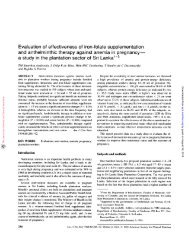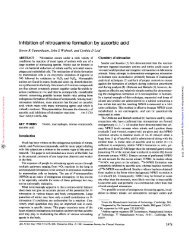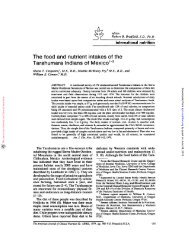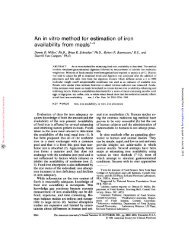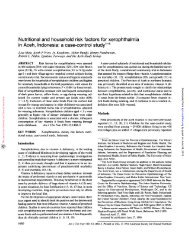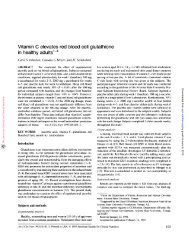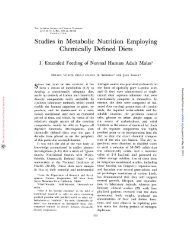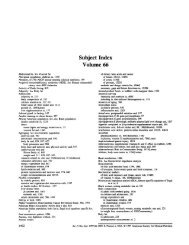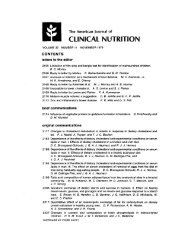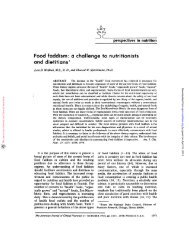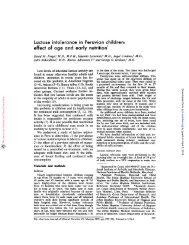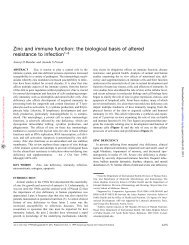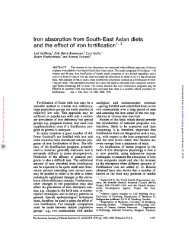Influence of D-Sorbitol on Absorption of Vitamin B12 by Patients with ...
Influence of D-Sorbitol on Absorption of Vitamin B12 by Patients with ...
Influence of D-Sorbitol on Absorption of Vitamin B12 by Patients with ...
You also want an ePaper? Increase the reach of your titles
YUMPU automatically turns print PDFs into web optimized ePapers that Google loves.
<str<strong>on</strong>g>Influence</str<strong>on</strong>g> <str<strong>on</strong>g>of</str<strong>on</strong>g> D-<str<strong>on</strong>g>Sorbitol</str<strong>on</strong>g> <strong>on</strong> Absorpti<strong>on</strong> <str<strong>on</strong>g>of</str<strong>on</strong>g><br />
<strong>Vitamin</strong> <strong>B12</strong> <strong>by</strong> <strong>Patients</strong> <strong>with</strong> Pernicious<br />
Anemia and Achlorhydria<br />
BACON CHOW, PH.D.,* STANLEY TAUBER, M.D.,t IRVING WOLDOW, M.D.4 SAMUEL YEll, M.D.,<br />
AND BRUNO RANKE, DR. RER. NAT.’t<br />
R ECENTLY, Chow et a!.’ reported <strong>on</strong> an elixir<br />
c<strong>on</strong>taining vitamin B,2 that produced<br />
serum vitamin B,, levels in healthy young and<br />
aged people that were significantly higher than<br />
could be obtained <strong>with</strong> larger oral doses <str<strong>on</strong>g>of</str<strong>on</strong>g> vitamiri<br />
B,2 al<strong>on</strong>e. In the same paper they reported<br />
that the elixir did not seem to be effective<br />
in treating patients for pernicious anemia.<br />
Later studies <strong>by</strong> Chow and others” established<br />
that the absorpti<strong>on</strong>-enhancing factor in<br />
the elixir was D-sorbitol, a substance which is<br />
not derived from intrinsic factor. The studies<br />
also indicated that when enough D-sorbitol is<br />
adniinistered <strong>with</strong> vitamin B,, there is a statistically<br />
significant increase in absorpti<strong>on</strong><br />
<str<strong>on</strong>g>of</str<strong>on</strong>g> the vitamin <strong>by</strong> pregnant women and old<br />
4 Other investigators dem<strong>on</strong>strated<br />
this unusual property <str<strong>on</strong>g>of</str<strong>on</strong>g> D-sorbitol in normal<br />
subjects’ and in laboratory animals.’’<br />
Although D-sorbitol did not improve absorpti<strong>on</strong><br />
<str<strong>on</strong>g>of</str<strong>on</strong>g> vitamin B,, <strong>by</strong> patients <strong>with</strong> pernicious<br />
anemia, its established ability to improve<br />
absorpti<strong>on</strong> in other types <str<strong>on</strong>g>of</str<strong>on</strong>g> patients led us to<br />
test it <strong>on</strong>ce again in patients <strong>with</strong> pernicious<br />
anemia <strong>on</strong> the chance that our original finding<br />
might be in error. The effect <str<strong>on</strong>g>of</str<strong>on</strong>g> sorbitol <strong>on</strong> the<br />
From the 1)epartmiie,it <str<strong>on</strong>g>of</str<strong>on</strong>g> Biochemistry, School <str<strong>on</strong>g>of</str<strong>on</strong>g><br />
Hygiene and Public Health, The Johns Hopkins University,<br />
Baltimll Ire, Maryland.<br />
* Department (If Biochemistry, Johns Hopkins University<br />
; t Assistant in I’sIedicine afl(1 Department <str<strong>on</strong>g>of</str<strong>on</strong>g><br />
Research, Albert Einstein Medical Center, Philadelphia,<br />
Pcnnsylva,lia. 4 L)epartncmit (If Hematology, Albert<br />
Einstein Medical Center, Northern I)ivisi<strong>on</strong>, Philadclphia,<br />
Pennsylvania. § Department <str<strong>on</strong>g>of</str<strong>on</strong>g> Biocliemistr,<br />
Johns Hopkins University; Present address: Universitats-Krankenhaus<br />
Eppemid Irf, Hamburg, Germa,iy.<br />
absorpti<strong>on</strong> <str<strong>on</strong>g>of</str<strong>on</strong>g> vitamin B,, <strong>by</strong> subjects <strong>with</strong><br />
achlorhydria was also studied.<br />
MATERIALS AND METHODS<br />
<strong>Patients</strong> <strong>with</strong> Pernicious Anemia<br />
Twelve patients <strong>with</strong> pernicious anemia in remissi<strong>on</strong><br />
participated in the study. The diagnoses<br />
<str<strong>on</strong>g>of</str<strong>on</strong>g> pernicious anemia were made <strong>by</strong> b<strong>on</strong>emarrow<br />
tests and <strong>by</strong> determining the amount <str<strong>on</strong>g>of</str<strong>on</strong>g><br />
vitamin B,, excreted in the urine.<br />
In the urinary excreti<strong>on</strong> test, 2 g <str<strong>on</strong>g>of</str<strong>on</strong>g> radioactive<br />
vitamin B,, labeled <strong>with</strong> Co’#{176} (specific<br />
activity,<br />
1Sf) .tc/mg) was administered to the patient<br />
in 30 ml <str<strong>on</strong>g>of</str<strong>on</strong>g> water <strong>with</strong> which the c<strong>on</strong>tainer<br />
was rinsed. Two hours later, the patient was<br />
given an intramuscular injecti<strong>on</strong> <str<strong>on</strong>g>of</str<strong>on</strong>g> l00() g <str<strong>on</strong>g>of</str<strong>on</strong>g><br />
unlabeled vitamin B,,. Urine was then collected<br />
from the patient for 24 hours. After measuring<br />
the volume <str<strong>on</strong>g>of</str<strong>on</strong>g> urine, <strong>on</strong>e half was evaporated<br />
<strong>on</strong> a steam bath until less than 50 ml remained.<br />
The amount <str<strong>on</strong>g>of</str<strong>on</strong>g> radioactivity in this<br />
residue was measured <strong>by</strong> a scintillati<strong>on</strong> counter.<br />
Three or more m<strong>on</strong>ths later, the test was repeated,<br />
using 10 ml <str<strong>on</strong>g>of</str<strong>on</strong>g> a Go per cent aqueous soluti<strong>on</strong><br />
<str<strong>on</strong>g>of</str<strong>on</strong>g> D-sorbitol in place <str<strong>on</strong>g>of</str<strong>on</strong>g> 10 ml <str<strong>on</strong>g>of</str<strong>on</strong>g> water.<br />
Subjects <strong>with</strong> Achiorhydria<br />
A total <str<strong>on</strong>g>of</str<strong>on</strong>g> 19 subjects <strong>with</strong> achlorhydria<br />
which was diagnosed <strong>by</strong> gastric juice analysis<br />
and/or <strong>by</strong> DiagnexJ feeding were randomly divided<br />
into two groups. Group A (10 patients)<br />
received 50 ig <str<strong>on</strong>g>of</str<strong>on</strong>g> radioactive vitamin B,,<br />
al<strong>on</strong>e, and Group B (9 patients) received the<br />
#{182} Kindly supplied to us <strong>by</strong> E. R. Squibb & S<strong>on</strong>s, Inc.;<br />
equal to quinine resin.<br />
Downloaded from ajcn.nutriti<strong>on</strong>.org <strong>by</strong> guest <strong>on</strong> August 31, 2013<br />
11 nzerica n iou rue! <str<strong>on</strong>g>of</str<strong>on</strong>g> C/in iCOl Autriti<strong>on</strong> 328 Vol. 7, )Iav-June 1959
D-<str<strong>on</strong>g>Sorbitol</str<strong>on</strong>g> in Pernicious Anemia and Achlorhydria 329<br />
same amount <str<strong>on</strong>g>of</str<strong>on</strong>g> vitamin B,2 together <strong>with</strong> 10<br />
ml <str<strong>on</strong>g>of</str<strong>on</strong>g> a (jo per cent aqueous soluti<strong>on</strong> <str<strong>on</strong>g>of</str<strong>on</strong>g> D-sorbitol.<br />
These studies were c<strong>on</strong>ducted <strong>on</strong> four separate<br />
occasi<strong>on</strong>s (identified as studies 1-4), <strong>with</strong><br />
the number <str<strong>on</strong>g>of</str<strong>on</strong>g> subjects in each group shown in<br />
Table II. Two hours later all subjects were injected<br />
<strong>with</strong> 1000 jg <str<strong>on</strong>g>of</str<strong>on</strong>g> unlabeled vitamin B,2 and<br />
their urine samples were collected for 24 hours<br />
for radioactivity measurement.<br />
‘I All results are expressed as per cent <str<strong>on</strong>g>of</str<strong>on</strong>g> the 2 pg <str<strong>on</strong>g>of</str<strong>on</strong>g><br />
radiovitamin B,, given orally.<br />
6 Approximate.<br />
RESULTS<br />
<strong>Patients</strong> <strong>with</strong> Pernicious Anemia<br />
Our studies <strong>with</strong> the urinary excreti<strong>on</strong> test in<br />
more than 100 healthy subjects show that the<br />
average normal excreti<strong>on</strong> is 1 1 .0 per cent <str<strong>on</strong>g>of</str<strong>on</strong>g> the<br />
test dose <str<strong>on</strong>g>of</str<strong>on</strong>g> vitamin B,2. As shown in Table I,<br />
in the first test all patients excreted less than 1.5<br />
per cent <str<strong>on</strong>g>of</str<strong>on</strong>g> the dose <str<strong>on</strong>g>of</str<strong>on</strong>g> vitamin B,2, thus c<strong>on</strong>firming<br />
the diagnoses <str<strong>on</strong>g>of</str<strong>on</strong>g> pernicious anemia.<br />
The test <strong>with</strong> D-sorbitol dem<strong>on</strong>strated that a’60<br />
per cent aqueous soluti<strong>on</strong> <str<strong>on</strong>g>of</str<strong>on</strong>g> D-sorbitol had no<br />
effect <strong>on</strong> the absorpti<strong>on</strong> <str<strong>on</strong>g>of</str<strong>on</strong>g> orally administered<br />
vitamin B,2 <strong>by</strong> patients <strong>with</strong> pernicious anemia;<br />
D-sOrbitol increased absorpti<strong>on</strong> in <strong>on</strong>ly 1 <str<strong>on</strong>g>of</str<strong>on</strong>g> the<br />
12 patients tested (patient 5 in Table I).<br />
Subjects <strong>with</strong> Achiorhydria<br />
The data <strong>on</strong> the urinary excreti<strong>on</strong> <str<strong>on</strong>g>of</str<strong>on</strong>g> subjects<br />
TABLE<br />
Effect <str<strong>on</strong>g>of</str<strong>on</strong>g> D-<str<strong>on</strong>g>Sorbitol</str<strong>on</strong>g> <strong>on</strong> the Urinary Excreti<strong>on</strong> <str<strong>on</strong>g>of</str<strong>on</strong>g> Orally<br />
Fed RadioactiVe <strong>Vitamin</strong> B,, <strong>by</strong> <strong>Patients</strong> <strong>with</strong><br />
Patient<br />
1<br />
2<br />
3<br />
Pernicious<br />
C Only significant increase (low normal range).<br />
I<br />
Anemiaa<br />
<strong>Vitamin</strong> <strong>B12</strong><br />
+ water<br />
0.1<br />
05b<br />
05b<br />
<strong>Vitamin</strong> BI2<br />
+ sorbitol<br />
. 0.7<br />
0.5<br />
0.5<br />
4 0.1 0.1<br />
5 1.5 5.0c<br />
6 0.1 0.1<br />
7 0.5 1.0<br />
S 0.6 1.5<br />
9 - 1.2<br />
10 - 1.4<br />
11 - 0.5<br />
12 - 1.4<br />
TABLE<br />
Effect <str<strong>on</strong>g>of</str<strong>on</strong>g> D-<str<strong>on</strong>g>Sorbitol</str<strong>on</strong>g> <strong>on</strong> the l.ninary Excreti<strong>on</strong> <str<strong>on</strong>g>of</str<strong>on</strong>g> Orally<br />
Fed Radioactive \‘ita1nin B,, <strong>by</strong> Subjects <strong>with</strong><br />
Study<br />
Subject<br />
No.<br />
Achlorhvdnia”<br />
a All results are expressed as per cent <str<strong>on</strong>g>of</str<strong>on</strong>g> the 50 pg <str<strong>on</strong>g>of</str<strong>on</strong>g><br />
radiovitamin B,, given orally.<br />
b Only a small porti<strong>on</strong> <str<strong>on</strong>g>of</str<strong>on</strong>g> the 24-hour urine specimen<br />
was collected and was, therefore, discarded.<br />
C Mean and standard error. The difference in the<br />
means <str<strong>on</strong>g>of</str<strong>on</strong>g> both groups is statistically significant (p <<br />
0.01) calculated according to the Students’ t test.<br />
II<br />
Group A<br />
(vitamin B,,<br />
+ water)<br />
1 1 1.61 2.38<br />
2 1.22 3.83<br />
3 2.14 3.17<br />
2 4 0.51 1.91<br />
3 7<br />
8<br />
5 0.81 1.06<br />
6 1.66 2.34<br />
9<br />
1.73<br />
1.22<br />
0.56<br />
Group B<br />
(vitamin 1312<br />
+ sorhitol)<br />
1.35<br />
2.21<br />
b<br />
4 10 0.65 1.83<br />
MEANC 1.21 ± 0.178 2.23 ± 0.284<br />
in Groups A and B are presented in Table II.<br />
They dem<strong>on</strong>strate that a 60 per cent aqueous<br />
soluti<strong>on</strong> <str<strong>on</strong>g>of</str<strong>on</strong>g> sorbitol enhances the absorpti<strong>on</strong> <str<strong>on</strong>g>of</str<strong>on</strong>g><br />
orally administered vitamin B,2 <strong>by</strong> subjects<br />
<strong>with</strong> achlorhydria. The same effect was observed<br />
in four separate studies, and the difference<br />
in the urinary excreti<strong>on</strong> <str<strong>on</strong>g>of</str<strong>on</strong>g> radioactivity is<br />
statistically<br />
significant.<br />
DISCUSSION<br />
The finding that D-sorbitOl does not increase<br />
absorpti<strong>on</strong> <str<strong>on</strong>g>of</str<strong>on</strong>g> orally administered vitamin B,2<br />
<strong>by</strong> patients <strong>with</strong> pernicious anemia agrees <strong>with</strong><br />
the findings <str<strong>on</strong>g>of</str<strong>on</strong>g> Ellenbogen and his associatestm#{176}<br />
and c<strong>on</strong>firms our original observati<strong>on</strong>.<br />
The lack <str<strong>on</strong>g>of</str<strong>on</strong>g> efficacy clearly differentiates<br />
D-sorbitol from intrinsic factor, which <strong>by</strong> definiti<strong>on</strong><br />
must increase absorpti<strong>on</strong> <str<strong>on</strong>g>of</str<strong>on</strong>g> vitamin B,2<br />
in patients <strong>with</strong> pernicious anemia. Since<br />
D-sorbitol can be effective in increasing absorpti<strong>on</strong><br />
<str<strong>on</strong>g>of</str<strong>on</strong>g> vitamin B,, in patients where there is no<br />
dem<strong>on</strong>strable lack <str<strong>on</strong>g>of</str<strong>on</strong>g> intrinsic factor, or even in<br />
subjects <strong>with</strong> achlorhydria, it appears that<br />
there are a number <str<strong>on</strong>g>of</str<strong>on</strong>g> different mechanisms <strong>by</strong><br />
which vitamin B,, is absorbed from the gastrointestinal<br />
tract.<br />
Downloaded from ajcn.nutriti<strong>on</strong>.org <strong>by</strong> guest <strong>on</strong> August 31, 2013
330 Chow, Tauber, Woldow, Yeh, and Ranke<br />
SUMMARY AND CONCLUSIONS<br />
D-sorbitol, a substance which is not derived<br />
from intrinsic factor, has been found to increase<br />
the absorpti<strong>on</strong> <str<strong>on</strong>g>of</str<strong>on</strong>g> orally administered vitamin<br />
B,2 <strong>by</strong> certain patients who presumably possess<br />
intrinsic factor. As seen in this study, however,<br />
D-sorbitol did not increase the absorpti<strong>on</strong><br />
<str<strong>on</strong>g>of</str<strong>on</strong>g> vitamin B,, <strong>by</strong> patients <strong>with</strong> pernicious<br />
anemia, but it did enhance the absorpti<strong>on</strong> in<br />
subjects <strong>with</strong> achlorhydria. Thus, these findings<br />
together <strong>with</strong> others2’3 dem<strong>on</strong>strate that<br />
D-sorbitol can aid to some extent the absorpti<strong>on</strong><br />
<str<strong>on</strong>g>of</str<strong>on</strong>g> vitamin B,, <strong>by</strong> all types <str<strong>on</strong>g>of</str<strong>on</strong>g> subjects studied<br />
except those <strong>with</strong> pernicious anemia.<br />
REFERENCES<br />
1. C,iow, B. F. , H0R0NIcK, A., and OKUDA, K. : Effeet<br />
(If an elixir (111 the absorpti<strong>on</strong> <str<strong>on</strong>g>of</str<strong>on</strong>g> vitamin B,,<br />
<strong>by</strong> healthy young and old subjects. AM. J. CLIN.<br />
NuTRITIoN 4: 434, 1956.<br />
2. Cnow, B. F., MEIER, P., and FREE, S. M., JR.: Absorpti(I,1<br />
<str<strong>on</strong>g>of</str<strong>on</strong>g> vitamin B,, enhanced <strong>by</strong> D-s<strong>on</strong>bitol.<br />
AM. J. CLIN. NUTRITION 6: 30, 1958.<br />
3. Cnow, B. F., PRYSTOVSKY, H., HELLEGERS, A. E.,<br />
and WONG, \‘. : \itamin B,, studies: Absorpti<strong>on</strong><br />
in human pregnancy enhanced <strong>by</strong> D-s<strong>on</strong>bitol.<br />
Am. J. Obst. & Gynec. 76: 91, 1958.<br />
4. CHOW, B. F., et al. : To be published.<br />
5. CORNMAN, E. : Elevatio,, <str<strong>on</strong>g>of</str<strong>on</strong>g> plasma B,, levels after<br />
oral administrati<strong>on</strong> <str<strong>on</strong>g>of</str<strong>on</strong>g> vitamin B,, and a ‘ ‘ n<strong>on</strong>intrinsic<br />
factor’ ‘ additive to humans. Presented<br />
at New York Academy <str<strong>on</strong>g>of</str<strong>on</strong>g> Medici,,e Symposium<br />
<strong>on</strong> <strong>Vitamin</strong> B,,, February, 1958.<br />
6. GREENBERG, S. M., HERNDON, j. F., RIcE, E. 0.,<br />
PARMELEE, E. T., GULESICH, J. J., and VAN<br />
LooN, E. J. : Enhancement <str<strong>on</strong>g>of</str<strong>on</strong>g> vitamin B,, absorpti<strong>on</strong><br />
<strong>by</strong> substances other than intrinsic fact<strong>on</strong>.<br />
Nature, L<strong>on</strong>d<strong>on</strong> 18(): 1401, 1957.<br />
7. R,cr, E. G., HERNDON, j. F., VAN LooN, E. J., and<br />
GREENBERG, S. M. : Enhancemet <str<strong>on</strong>g>of</str<strong>on</strong>g> vitamin<br />
B,, absorpti<strong>on</strong> b D-s<strong>on</strong>bitol as measured <strong>by</strong> maternal<br />
and fetal tissue levels in pregnant rats.<br />
Am. J. Phi’siol. 193: 513, 1958.<br />
8. MORGAN, T. B. and VUDKIN, J. : The vitaminsparing<br />
acti<strong>on</strong> <str<strong>on</strong>g>of</str<strong>on</strong>g> s<strong>on</strong>bitol. Nature, L<strong>on</strong>d<strong>on</strong> 180:<br />
543, 1957.<br />
9. LATNER, A. L. : Intrinsic fact;n and vitamin B,,<br />
absorpti<strong>on</strong>. Brit. M. J. 2: 278, 1958.<br />
10 ELLENBOGEN, L. : Effect <str<strong>on</strong>g>of</str<strong>on</strong>g> sorbitol <strong>on</strong> vitamin B,,<br />
absorpti<strong>on</strong> in pernicious anemia patients. Pnesented<br />
at a \‘itamin B,, Symposium, Society for<br />
the Study <str<strong>on</strong>g>of</str<strong>on</strong>g> Bkxd, New \<strong>on</strong>k City, April, 1958.<br />
Downloaded from ajcn.nutriti<strong>on</strong>.org <strong>by</strong> guest <strong>on</strong> August 31, 2013



